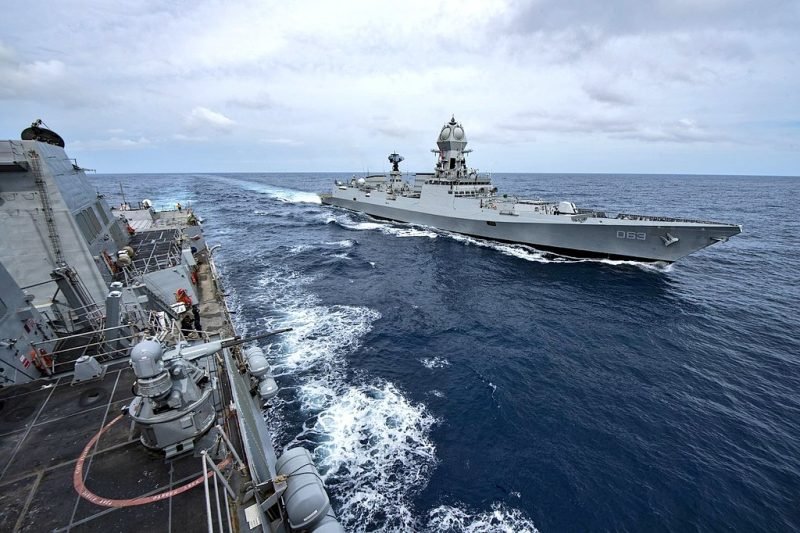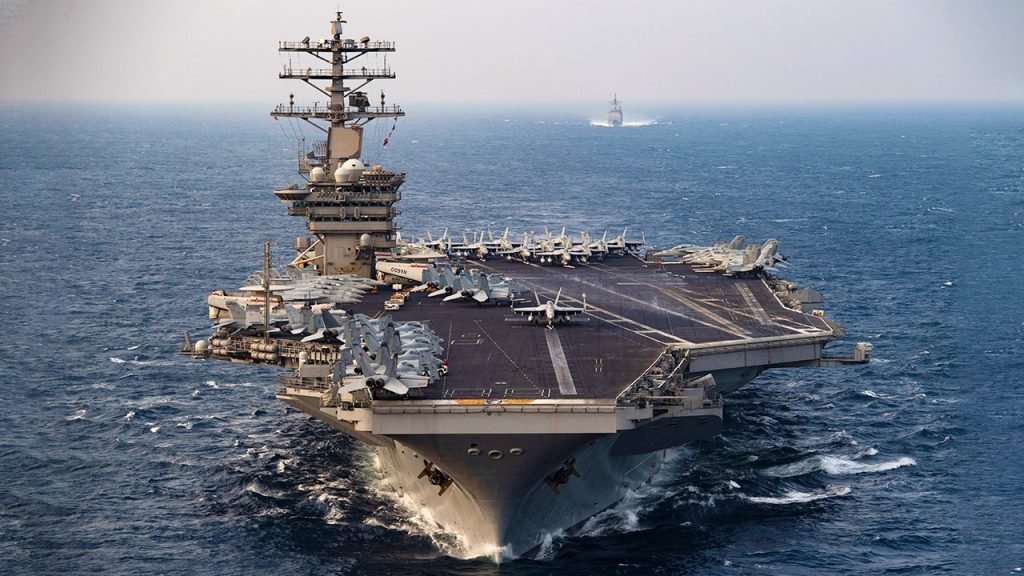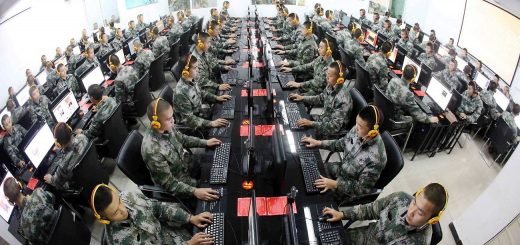24th Edition of Malabar Naval Exercise: The year 2020

On 20th November 2020, the 24th edition of the Malabar exercise was concluded. The USA, India, Australia, and Japan are partners in Malabar Naval exercise. India was the host country in this edition. The exercise started in the year 1992 between the Indian navy and the US navy. Later on, Japan became a permanent partner of Malabar in 2015. As far as Australia is concerned, it denied becoming a Quad member in 2007-2008. In the year 2020, the third Quad ministerial meeting took place at Tokyo, Japan. After a few days of a meeting, the Indian government announced that Australia would be participating in the Malabar Naval exercise of 2020. It took place in two phases; the first phase was from 3rd November to 6th November 2020 in the Bay of Bengal, and the 2nd Phase was between the 17th November to 20th November 2020 in the northern Arabian Sea, off the western coast of India.
The Malabar exercise is known as a high-end technical and superior naval exercise; thus, it has strategic significance. Apart from that, the major democratic players are participants of this exercise who have shared aims and objectives such as free, open, and inclusive towards the Indo-Pacific region. The 2020 Malabar exercise takes place in the Arabian sea and in the Bay of Bengal which is part of the Indian Ocean region (IOR). Both the seas have their geostrategic significance to India and Indo-Pacific. It’s the busiest sea route and trade route for Southeast and East Asia. As far as China is concerned, China’s oil route passes through the Arabian sea and also through the Bay of Bengal towards Myanmar.

Importance of Malabar Exercise
All types of military exercises are made for the transfer of knowledge, interoperability between the technology, and co-operation between the armed forces. The co-operation and interoperability between the forces are some of the major factors of warfare in the 21st century. Capt. Manoj Rawat, former Indian naval captain, and director of naval operations at the Naval Headquarters, New Delhi in his article said that “maritime security is a common ground between the Quad countries; thus, increasing interoperability between the navies should be the priority”. Furthermore, he says, “despite China’s aggressive activities in the South China Sea they are vulnerable at Seas”. From this statement, it seems that China’s naval capabilities are not thoroughly tested yet. The countries need to engage in military exercises to test the capabilities and performance of military technologies in real-time. Thus, Capt. Rawat stated, improving sharing intelligence, better interoperability, shared logistics, secure communications are the key areas where Quad countries must year-round focus rather than just during the annual Malabar exercise. With the similar context of the significance of military exercises, it has strategic significance, it is a diplomatic tool for political signaling. The host country and participants can convey a strong message to an opponent. It also helps forces to understand each other’s military drills and tactics. It enhances the familiarity with weapons and technology. It also reduces language and technical communication barriers. Military exercises and drills help forces in operations other than war (OOTW), humanitarian aid, counter-piracy operations, joint coastal patrolling and surveillance missions, etc.
First Phase of the exercise
The first phase of Malabar concluded with advanced level military drills, anti-submarine, and anti-air warfare drills, weapons firing exercises, cross-deck flying, and seamanship maneuvers. The US Navy’s ship USS John S Mc Cain[(Guided-missile destroyer)(Code-DDG56)], Australia’s HMAS Ballarat [(Long-range frigate)(Code-FFG 115)] with integral MH60 Helicopter, Japan’s JS Onami [(Destroyer) (Code-DD111)] with integral SH60 Helicopter and Indian Naval Unit [Shakti(A57), Ranvijay(D55), Shivalik(F47), Submarine Sindhuraj(S57), Offshore patrol vessel Sukanya] have participated in the exercise. Also, long-range patrol aircraft, advance jet trainer Hawk, Dornier maritime patrol aircraft and helicopters participated in the Exercise. The Indian naval unit was commanded by Rear Admiral Sanjay Vatsyayan, a flag officer commanding the eastern fleet.
Second Phase of the Exercise
The second phase concluded with the same enthusiasm and advance maritime exercises between the four naval forces at the North Arabian sea. The Indian Naval unit was commanded by Rear Admiral Krishna Swaminathan, Flag Officer Commanding Western Fleet.
The Significance of the second phase of the exercise is the participation of the carrier battle group of INS Vikramaditya, its fighter aircrafts MIG 29K, and integral helicopters. Indian Navy’s destroyers such as INS Kolkata, Chennai, Stealth Frigate Talwar, Support ship Deepak and integral helicopters participated in the Exercise from the Indian Navy.
On the US Naval Side, Strike Carrier Nimitz participated with Cruiser Princeton and destroyer Street in addition to P8A maritime reconnaissance aircraft. From the Royal Australian Navy, Frigate Ballarat along with its integral helicopters and Japanese naval ships participated in the exercise.
For the four days, the Quad navies participated in high-intensity naval operations. These exercises include cross-deck flying, which had also been practised in the first phase. ‘Dual carrier’ exercise conducted by the navies. Also, Air defence exercises by MIG 29K fighter aircrafts integrated with INS Vikramaditya and F-18 fighters, E2C Hawkeye from the US Nimitz. The press statement released by the Ministry of Defence, India said, “advanced surface and anti-submarine warfare exercises, seamanship evolutions and weapon firings will also be undertaken to enhance interoperability and synergy between the four friendly navies.”

Statements from the Naval officers participated in the Exercise
The Indian Naval officer, Rear Admiral Krishna Swaminathan said that this edition of Malabar was unique from previous exercises. He highlighted three major points One, the exercise conducted in the Bay of Bengal and Arabian sea which are peninsular to India. Secondly, Quad countries participated after a long gap and, third, the interoperability between the four navies. Vice Admiral M S Pawar, deputy chief of the Indian navy stated that “It is an honour for Indian navy to host the 24th edition of Malabar exercise together with the highly professional navies such as the US, Australia, and Japan. Malabar 2020 helps us to showcase our combat readiness, interoperability, and determination to tackle any challenge in the maritime domain. But most importantly, Malabar 2020 also helps us to reassure the international community about our collective commitment to a free, open, inclusive, and rules-based Indo-Pacific with the ASEAN its centrality at its very core.”
Destroyer Squadron 9 commander, Captain Elaine Collins, said: “The exercises conducted during Malabar provided opportunities to enhance our interoperability and strengthen our maritime partnerships with India, Australia, and Japan. Our ability to replenish ships at sea, conduct live firing exercises, and communicate with one another, ship-to-ship, demonstrates our cooperation and shared goals of fostering security and stability in the Indo-Pacific region.”
Australian Naval officers who participated in the exercise also expressed their positive views on the Quadrilateral Malabar maritime exercise.
Cmdr. Ishidera Takahikoo, Japanese Commanding officer of JS Onami Said, “We, the JMSDF, have been striving to strengthen partnership among the navies of friendly nations through maritime exercises such as Malabar to achieve a free and open Indo-Pacific.”
The common key point between all forces and also highlighted by naval officers was the ‘interoperability’. Therefore, it reflects the importance of technical interoperability and effective communications in high-end naval operations under the umbrella of highly sophisticated technologies. It also signals that there’s a geopolitical demand to conduct highly technically sophisticated maritime exercises to enhance security in the Indo-Pacific region and to promote an international rules-based order in the maritime domain.
Conclusion
Indo-US strategic defence and security co-operation is enhancing day by day. India has signed major security pacts such as GSOMIA (General security of military information agreement), LEMOA (Logistic exchange memorandum of agreement), COMCASA (Communications compatibility and security agreement), BECA (Basic exchange cooperation agreement). India has signed a strategic partnership agreement with Japan and Australia. India has also signed a Mutual logistic exchange agreement (MLEA) with Australia and Japan which would enhance India’s naval presence in East Asia and the Pacific. India is importing high-end technologies for Maritime security from the US. India is using the P8I of the US for surveillance and reconnaissance in the maritime domain. Australia also uses the same technology. Indian conducts regular bilateral maritime exercises with Japan, Australia, and the US. That’s why exercises like Malabar enhances the togetherness between the four countries. Directly or indirectly, Technological and in the geopolitical areas, Quad countries are interlinked and connected. China’s activities in the Indo-Pacific region are a concern for Quad counties. Thus, the geopolitical construct of Indo-Pacific and the equations of ‘Quad’, as well as ‘Malabar’, are an outcome of it. The 24th edition of Malabar can be seen as a successful attempt of ‘strategic signalling’ to China and its allies. At the same time, how much its ability to contain China’s behaviour in the region needs to be watched in upcoming years.
References
Australian Navy (November 2020) Retrieved from-https://www.youtube.com/watch?v=KX8UFcalmhA. Accessed Date- 30th November 2020.
Economic Times (November 7, 2020). Navies of India, US, Japan, Australia conclude phase 1 of Malabar 2020 naval exercise. Retrieved from- https://economictimes.indiatimes.com/news/defence/navies-of-india-us-japan-australia-conclude-phase-1-of-malabar-2020-naval-exercise/articleshow/79097428.cms. Accessed Date- 24th November 2020.
Indian Navy (November 2020) Phase 2 of Exercise Malabar 2020 in Western Indian Ocean. Retrieved from- https://indiannavy.nic.in/node/27125 . Accessed Date- 24th November 2020.
Indian Navy (November 2020). Malabar Phase-1. Retrieved from-https://www.youtube.com/watch?v=KaSeDAKBmaw. Accessed Date- 24th November 2020. Accessed Date- 24th November 2020.
Indian Navy (November 2020) Malabar Phase- 2. Retrieved from-https://www.youtube.com/watch?v=-qsRfNKFbHg. Accessed Date- 30th November 2020.
Naval Technology (November 23, 2020). Second phase of multi-lateral naval Exercise Malabar 2020 concludes. Retrieved from- https://www.naval-technology.com/news/second-phase-of-multi-lateral-naval-exercise-malabar-2020-wraps-up/. Accessed Date- 30th November 2020.
PIB India (October 19, 2020) Ministry of Defence, Malabar 2020 Naval exercise. Retrieved from- https://pib.gov.in/PressReleseDetailm.aspx?PRID=1665830. Accessed Date- 21st October 2020
PIB India (November 2nd 2020) Ministry of Defence Malabar- 2020. Retrieved from- https://www.pib.gov.in/PressReleseDetail.aspx?PRID=1669481. Accessed Date- 3rd November 2020.
Rawat M (November 23, 2020) Quad 2.0 Is Off to a Good Start – It Must Keep Going. Retrieved from- https://thediplomat.com/2020/11/quad-2-0-is-off-to-a-good-start-it-must-keep-going/. Accessed Date- 30th November 2020.
Sagar P. (November 4, 2020) India flexes its naval muscle with its Quad partners in Malabar 2020. Retrieved from- https://www.theweek.in/news/india/2020/11/04/india-flexes-its-naval-muscle-with-its-quad-partners-in-malabar-2020.html. Accessed Date- 30th November 2020.
Singh M. Ask an Expert. Retrieved from- https://idsa.in/askanexpert/internationalmilitaryexercises. Accessed Date- 24th November 2020.
The Hindu. (November 2020) Exercise Malabar Concludes in Arabian Sea. Retrieved from- https://www.thehindu.com/news/national/exercise-malabar-concludes-in-arabian-sea/article33143581.ece. Accessed Date- 20th November 2020.
US Navy (November 2020) Retrieved from-https://www.youtube.com/watch?v=Rf22eOXWO48. Accessed Date- 30th November 2020.


















